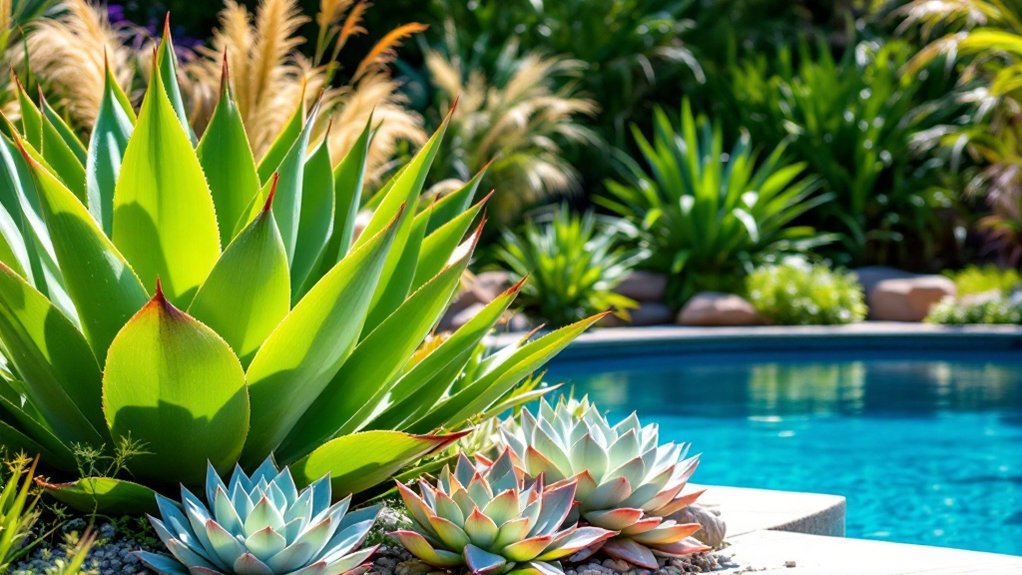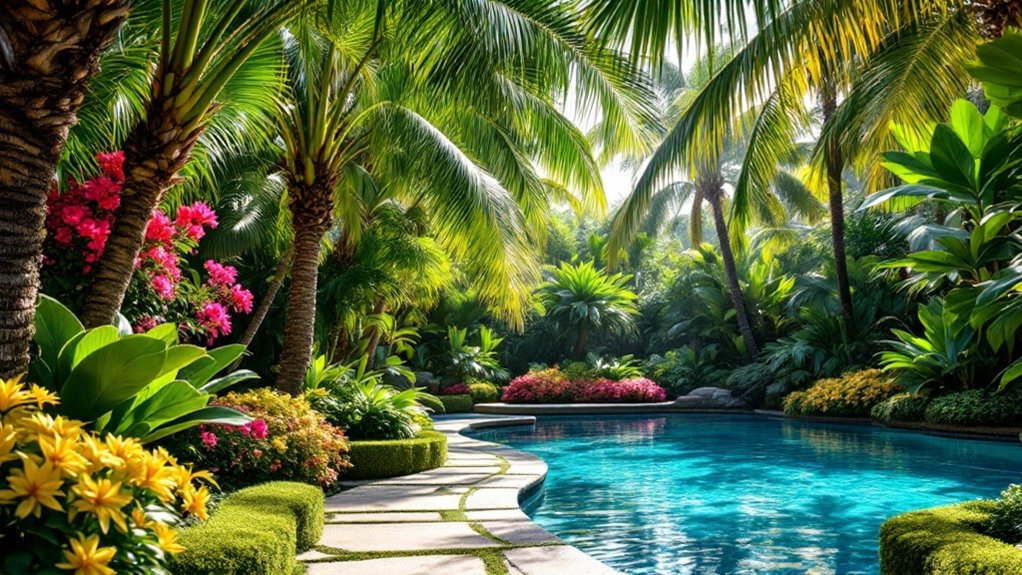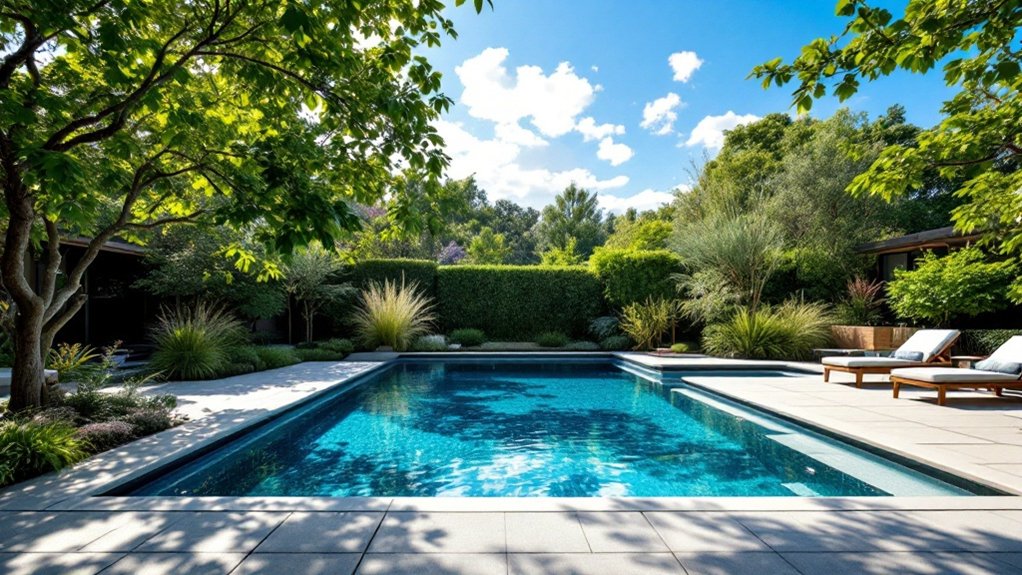Water-saving plants have become an essential consideration for poolside landscaping. These drought-resistant options not only conserve water but also enhance the visual appeal of outdoor spaces. From succulents to ornamental grasses, various choices exist to suit diverse aesthetics. Understanding their benefits and how to integrate them into a cohesive design can lead to a more sustainable environment. The next steps in selecting and maintaining these plants could transform a typical pool area into a vibrant, eco-friendly oasis.
Understanding Drought-Resistant Plants
What makes drought-resistant plants ideal for poolside landscapes? These plants possess unique adaptations that enable them to thrive in low-water conditions, making them perfect for xeriscaping around pools. They typically have deep root systems, allowing them to access moisture from deeper soil layers. Their waxy leaves minimize water loss, while some species have specialized structures to store water. Drought-resistant plants also require less maintenance, appealing to homeowners seeking low-effort landscaping solutions. Additionally, these plants can enhance the aesthetic appeal of pool areas, offering a variety of textures and colors without the need for excessive irrigation. By incorporating drought-resistant plants, poolside landscapes can remain vibrant and inviting while conserving precious water resources, aligning with sustainable landscaping practices.
Benefits of Water-Saving Plants
Water-saving plants offer significant advantages, particularly in reducing overall water consumption for poolside landscaping. In addition to conserving precious resources, these plants enhance the visual appeal of the pool area, creating a more inviting atmosphere. Their drought-resistant nature guarantees a sustainable and low-maintenance solution for homeowners.
Reduced Water Consumption
While many homeowners seek ways to enhance their poolside environment, embracing plants that require less water can greatly reduce overall water consumption. By selecting drought-tolerant varieties, individuals can maintain a lush landscape without the heavy reliance on irrigation systems. These water-saving plants are adept at thriving in various conditions, thereby minimizing the need for frequent watering. In addition, integrating such flora can contribute to lower water bills, making it an economically sound choice. As climate challenges intensify, the adoption of these plants also supports sustainable landscaping practices. Ultimately, reducing water consumption not only benefits the environment but also allows homeowners to enjoy a serene outdoor space with minimal resource expenditure.
Enhanced Pool Aesthetics
Choosing drought-tolerant plants not only conserves water but also enhances the visual appeal of pool areas. These plants can create a vibrant and inviting atmosphere around swimming pools, contributing to a harmonious landscape. Varieties such as succulents, ornamental grasses, and native shrubs offer unique textures and colors, enriching the overall aesthetic. By strategically placing these plants, homeowners can design eye-catching focal points that draw attention without overwhelming the space. Additionally, water-saving plants often require less maintenance, allowing for a more effortless upkeep and a serene environment. Ultimately, incorporating drought-resistant flora not only promotes sustainability but also elevates the beauty of poolside settings, making them more enjoyable for relaxation and entertainment.
Top Water-Saving Plants for Poolside
When designing a poolside landscape, selecting plants that require minimal water can greatly enhance both aesthetics and sustainability. Some of the top water-saving plants include succulents, which store water in their leaves, making them ideal for arid climates. Lavender, with its fragrant blooms, not only thrives in dry conditions but also attracts pollinators. Ornamental grasses, like Blue Fescue, offer texture and movement while requiring little irrigation. Additionally, Mediterranean herbs such as rosemary and thyme provide culinary benefits along with drought resistance. Native plants, adapted to local climates, are often the best choices, as they typically need less water. Incorporating these plants can create a beautiful and eco-friendly poolside environment that conserves water.
Designing Your Poolside Landscape
When designing a poolside landscape, the selection of drought-resistant plants is essential for sustainability. Incorporating natural stone features can enhance the aesthetic while minimizing water usage. Additionally, creating shaded areas adds comfort and encourages outdoor enjoyment without excessive water consumption.
Selecting Drought-Resistant Plants
Selecting drought-resistant plants for a poolside landscape not only enhances the visual appeal but also promotes water conservation. These plants are specifically adapted to thrive in arid conditions, requiring minimal irrigation once established. Options such as succulents, ornamental grasses, and native perennials can provide vibrant colors and textures while reducing the overall water usage of the landscape. Moreover, incorporating a variety of heights and forms can create visual interest, making the pool area more inviting. It is crucial to take into account the local climate and soil conditions when selecting these plants to guarantee their longevity and health. By choosing drought-resistant varieties, homeowners can enjoy a beautiful poolside environment that is both sustainable and eco-friendly.
Incorporating Natural Stone Features
Incorporating natural stone features into a poolside landscape can elevate the overall aesthetic while harmonizing with drought-resistant plant selections. These elements, such as flagstone patios, decorative boulders, and stone pathways, not only enhance visual appeal but also offer functional benefits. Natural stone provides a durable surface that withstands harsh weather conditions and reduces maintenance needs. Additionally, stone walls or borders can create distinct zones, separating the pool area from surrounding landscaping, while providing a natural backdrop for resilient plants. By using local stone varieties, homeowners can create a cohesive look that blends seamlessly with the environment. This approach promotes both beauty and sustainability, making it a valuable consideration for any poolside design.
Creating Shade and Comfort
Creating a comfortable poolside environment requires thoughtful consideration of shade options that enhance the overall experience. Shade can be achieved through various means, such as strategically placed trees, pergolas, or shade sails. Tall, deciduous trees not only provide cooling shade during hot summer months but also offer aesthetic appeal. Pergolas can be adorned with climbing plants, creating a natural canopy that filters sunlight while adding greenery. Shade sails, available in various colors and designs, offer flexible and stylish options for sun protection. Additionally, incorporating comfortable outdoor furniture beneath these shaded areas encourages relaxation and social interaction. By thoughtfully designing the landscape with shade in mind, homeowners can create a serene and inviting poolside retreat that promotes enjoyment and comfort.
Maintenance Tips for Drought-Resistant Plants
Maintaining drought-resistant plants requires a strategic approach to guarantee their health and longevity. Regular monitoring of soil moisture is essential; even drought-tolerant species need water during establishment. Implementing a deep watering schedule encourages root development, allowing plants to access moisture deeper in the soil. Mulching around the base helps retain soil moisture and suppresses weeds, which can compete for nutrients. Pruning spent flowers and dead foliage not only enhances appearance but also promotes airflow and reduces disease risk. Additionally, selecting native species often leads to greater resilience, as these plants are adapted to local conditions. Finally, periodic fertilization with a slow-release organic option can support healthy growth without excessive nutrient runoff.
Combining Aesthetics With Functionality
While designing a poolscape, homeowners often seek to balance visual appeal with practical benefits. Selecting water-saving plants can achieve this harmony, as many drought-resistant species offer vibrant colors, unique textures, and interesting forms. For instance, succulents and ornamental grasses not only require minimal water but also enhance the aesthetic charm of the pool area. Additionally, native plants can thrive in local climates, reducing maintenance efforts while providing habitats for wildlife. Incorporating these elements creates a serene environment that complements the pool’s design. Ultimately, a thoughtful combination of aesthetics and functionality guarantees that the pool area remains inviting and sustainable, allowing homeowners to enjoy their outdoor spaces without excessive resource consumption.
Seasonal Considerations for Planting
Understanding the seasonal climate variations is essential for selecting and planting water-saving species around pools. Different plants thrive in specific seasons, influencing their growth and water requirements. For example, spring is ideal for planting as temperatures rise, allowing roots to establish before the heat of summer. Conversely, fall planting can be beneficial in warmer climates, giving plants time to acclimate during milder weather. Winter presents challenges, particularly in colder regions where frost may damage tender species. Additionally, understanding local rainfall patterns helps in determining the best time for planting, as consistent moisture can support new growth. By aligning planting schedules with seasonal conditions, gardeners enhance the success of water-efficient landscaping around their pools.
Resources for Sustainable Gardening
As gardeners seek to establish sustainable landscapes around pools, a wealth of resources is available to guide their efforts. Local extension services often provide information on native plants and best practices for water conservation. Online platforms, such as gardening forums and websites, offer valuable insights into sustainable gardening techniques and plant choices. Additionally, books focusing on xeriscaping and eco-friendly landscaping can serve as thorough guides. Workshops and community events frequently promote sustainable practices and connect gardeners with experts. Social media groups dedicated to sustainable gardening can also facilitate knowledge sharing and inspiration. By leveraging these resources, gardeners can create inviting, eco-conscious poolside spaces that thrive with minimal water usage.
Frequently Asked Questions
Can I Use Native Plants for My Poolside Landscaping?
Native plants can be an excellent choice for poolside landscaping. They adapt well to local conditions, require less water, and support local wildlife, creating a sustainable and visually appealing environment around the pool area.
How Do I Choose the Right Plants for My Climate?
To choose the right plants for a specific climate, one should consider factors like temperature, humidity, soil type, and sunlight exposure, ensuring the selected plants thrive and contribute to a sustainable and aesthetically pleasing landscape.
Are There Any Water-Saving Plants That Attract Pollinators?
Inquiring about water-saving plants that attract pollinators reveals options like lavender, coneflower, and salvia. These plants not only conserve water but also support local ecosystems by drawing in bees, butterflies, and other beneficial insects.
What Is the Best Time of Year to Plant Water-Saving Plants?
The best time to plant water-saving plants typically falls in early spring or fall. These seasons provide ideal conditions for growth, allowing plants to establish roots before facing the heat of summer or the chill of winter.
How Do I Ensure My Water-Saving Plants Thrive in Poolside Conditions?
To guarantee water-saving plants thrive in poolside conditions, one should provide adequate drainage, select native species, maintain consistent moisture levels, and protect plants from pool chemicals while making certain they receive sufficient sunlight for growth.
Conclusion
Incorporating drought-resistant plants around pools not only enhances the landscape’s beauty but also promotes water conservation and ecological health. By understanding the benefits and selecting suitable plants, homeowners can create an inviting outdoor space that thrives in low-water conditions. With proper design and maintenance, these resilient plants will flourish, ensuring that the pool area remains both aesthetically pleasing and environmentally sustainable. Embracing this approach ultimately leads to a more responsible and enjoyable outdoor living experience.




